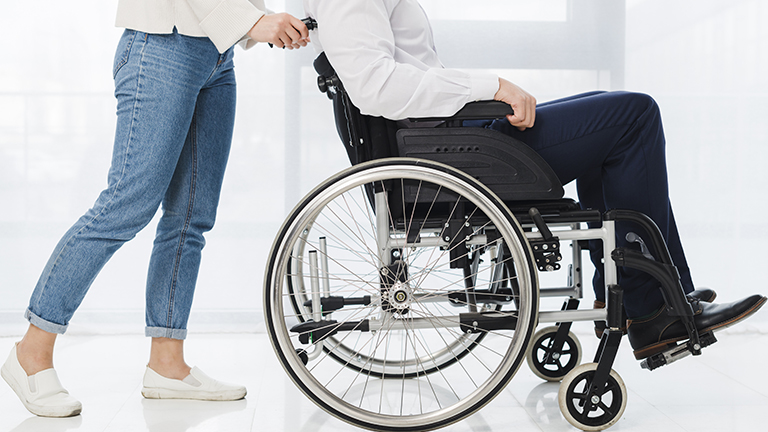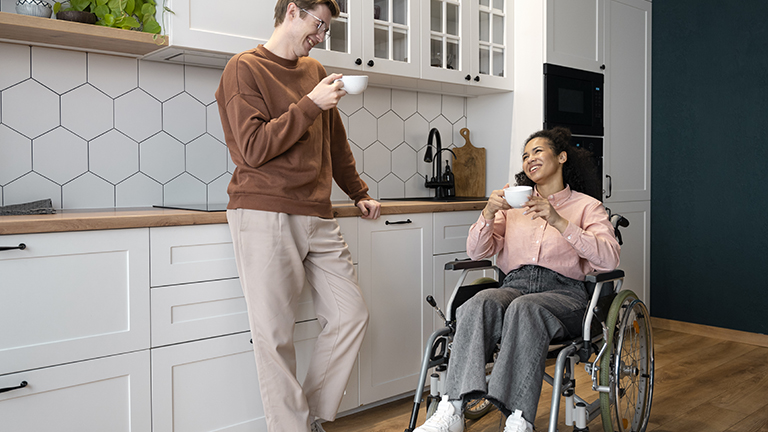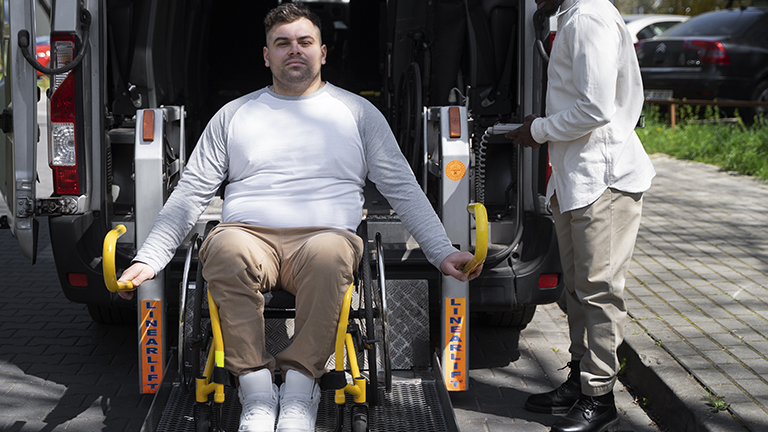A transfer boards for wheelchair users is a mobility aid designed to make moving between surfaces easier, safer, and more comfortable. It is typically a flat, sturdy board made of wood, plastic, or composite material that bridges the gap between a wheelchair and another surface such as a bed, chair, toilet, or car seat. By sliding across the board, individuals with limited mobility can transfer without having to stand up or rely entirely on physical lifting.
Wheelchair transfer boards are especially valuable for people with spinal cord injuries, neurological conditions, or weakened lower body strength. Caregivers also benefit, as they reduce the amount of physical strain required when assisting with transfers. This makes transfer boards a key tool for independence, dignity, and safety in daily living.
Benefits of Using a Transfer Board for Wheelchair Mobility
Transfer boards provide multiple benefits that go beyond convenience. They promote mobility, reduce risk of injury, and improve overall quality of life.
For wheelchair users, the primary benefit is increased independence. A well-designed transfer board allows a person to move from their wheelchair to a bed, toilet, or car without needing to be lifted. This provides privacy and autonomy in situations where assistance might otherwise be necessary.
Safety is another major advantage. Without a transfer board, manual lifting or pivoting poses risks such as falls, skin tears, and back injuries. Transfer boards provide a smooth surface that reduces friction, making transfers easier and minimizing strain on the shoulders and arms.
Caregivers also experience fewer injuries and less fatigue when using transfer boards. The reduced physical lifting helps prevent back injuries, which are common among healthcare workers and family caregivers.
Different Types of Transfer Boards for Wheelchairs
Not all transfer boards are the same, and choosing the right type depends on the user’s needs, environment, and level of independence.
Some boards are straight and simple, designed for short, direct transfers. Others are curved, providing more flexibility in positioning. Bariatric transfer boards are built for higher weight capacities, offering reinforced strength and durability.
Materials also vary. Wooden transfer boards are sturdy and affordable, while plastic or composite boards are lightweight, easier to clean, and often come with non-slip surfaces. Some feature hand slots or handles to provide extra grip and control during use.
Another variation is the sliding transfer board, which comes with a moving seat or disc that glides across the board. This reduces friction and makes the transfer process smoother, especially for individuals with limited upper body strength.
[INSERT_ELEMENTOR id=”5108″]
How to Choose the Best Transfer Board for Your Needs
Selecting the right transfer board is critical for safety and comfort. Factors such as weight capacity, board length, material, and design should all be considered.
For wheelchair to bed transfers, a longer board may be required to cover more distance. For car transfers, a curved board is often more effective since it allows maneuvering around fixed armrests or car doors. Bariatric users need a heavy-duty board that supports higher weight limits without compromising stability.
Material plays a significant role as well. Wooden boards are strong but heavier, making them less portable. Plastic or composite boards are lightweight and easy to transport, making them ideal for users who travel frequently. Boards with non-slip undersides and smooth surfaces also ensure safety during use.
When choosing a board, always check the manufacturer’s weight limit. A standard transfer board typically supports between 250–400 pounds, while bariatric models may hold up to 600 pounds.
Step-by-Step Guide: How to Use a Transfer Board Safely
Learning how to use a transfer board correctly is crucial for minimizing risks. The process involves preparation, positioning, and safe sliding techniques.
First, ensure that both surfaces—the wheelchair and the target location—are stable and as close as possible. Remove wheelchair armrests if necessary, or adjust them to allow enough room for the board.
Next, place one end of the transfer board under the user’s thigh or buttocks and the other end securely on the target surface. Lean slightly to one side while inserting the board, ensuring it does not slip out of place.
Using upper body strength, the individual can then slide slowly across the board, shifting weight carefully until fully seated on the target surface. Caregivers may provide gentle support at the hips or shoulders, but should avoid pulling forcefully to prevent injury.
Finally, once the transfer is complete, remove the board and reposition the wheelchair as needed.
Top Recommended Transfer Boards for Wheelchair Users
Choosing the right transfer board can feel overwhelming given the wide range of options available. However, several brands and models consistently rank among the best for their durability, safety, and ease of use.
Some highly recommended options include bariatric transfer boards for users requiring higher weight limits, curved boards designed for car transfers, and sliding transfer boards that minimize friction. Wooden transfer boards remain popular for their affordability and reliability, while composite models offer modern features like handles and non-slip textures.
Caregivers and wheelchair users often rely on reviews and expert recommendations to find the most suitable transfer board. Before purchasing, it is important to match the board to the specific environment where it will be used most frequently.
Top 5 Transfer Boards for Wheelchair Users
1. DMI Heavy-Duty Wood Transfer Board (Up to 440 lb)
- Why it stands out: Consistently named editor’s choice by BestReviews and BestReviews.guide for its durability and functionality Best Reviews GuideBestReviewstopbest10reviews.com.
- Key features:
- Sturdy ¾-inch pine construction
- Supports up to 440 lb
- Dual cut-out handles for secure grip
- Smooth-sanded, sealed finish for ease of sliding BestReviewsCar Repair MagKin Habits.
This board earns high praise from caregivers and therapists. Here’s a personal user testimonial:
“The cut-out handles provide extra leverage and a secure grip… robust wood material is thick and sanded for a smooth surface.”
— Caregiver reviewing DMI board Kin Habits.
2. BeasyTrans / BeasyGlyder Transfer System
- Why it stands out: Innovative design featuring a rotating glider disk for effortless transfers, repeatedly recommended by review sites Best Reviews GuideDisabilitease.
- Key features:
- 360° rotating disc slides friction-free
- Built for wheelchair-to-car, bed, or chair transfers
- Supports up to 400 lb
- Lightweight and portable Disabilitease.
This system is especially praised for car transfers and improving caregiver ergonomics.
3. Vive Transfer Board (Wooden, 36″ × 12″ or 30″ × 8″)
- Why it stands out: Offers a strong combination of comfort, safety, and portability; appears in multiple “best of” lists including BestReviews and TopBest10 topbest10reviews.comFindThisBest (UK)Car Repair Mag.
- Key features:
- Smooth, sealed wooden surface with rounded edges
- Dual handholds
- Supports roughly 400 lb
- Compact yet sturdy design topbest10reviews.comCar Repair Mag.
A trusted middle-weight option that balances grip, comfort, and durability.
4. JumboTIGER Curved ABS Plastic Transfer Board
- Why it stands out: Designed for tricky transfers—like wheelchair to car—thanks to its curved shape and slip-preventing rubber pads FindThisBestBest Reviews Guide.
- Key features:
- Curved shape for tight transfer angles
- ABS plastic construction with non-slip features
- Supports up to 330 lb
- Easy to clean and durable FindThisBestBest Reviews Guide.
Ideal for users needing a safer option in constrained spaces.
5. KMINA Sliding ABS Plastic Transfer Board (Up to 220 lb)
- Why it stands out: Simplicity and ease of use make this one a favorite in UK-based reviews FindThisBest (UK).
- Key features:
- Lightweight ABS plastic
- Cut-outs to fit around wheelchair parts and furniture
- Practical, user-friendly design
- Supports up to 220 lb FindThisBest (UK).
Best suited for lighter users or as a budget-friendly daily-use board.
Quick Comparison Table: Transfer Boards for Wheelchair
| Rank | Model | Material | Weight Capacity | Notable Feature |
| 1 | DMI Heavy-Duty Wood | Wood | ~440 lb | Editor’s choice; durable & smooth |
| 2 | BeasyTrans / BeasyGlyder | Plastic + metal | ~400 lb | Rotating disc for frictionless transfer |
| 3 | Vive Transfer Board | Wood | ~400 lb | Compact with dual handles and rounded edges |
| 4 | JumboTIGER Curved Board | ABS Plastic | ~330 lb | Curved shape, anti-slip pads |
| 5 | KMINA Sliding Transfer Board | ABS Plastic | ~220 lb | Lightweight, easy-fit design |
- For maximum strength and durability: Go with the DMI Heavy-Duty Board—a reliable workhorse.
- For low-friction, caregiver-friendly transfers: The BeasyTrans/BeasyGlyder system shines, especially for car transfers.
- For a balance of comfort and portability: Consider the Vive board.
- For transferring in tight spaces: The JumboTIGER curved board can be a real solution.
- On a light-duty budget: KMINA is approachable and practical for everyday use.
Common Mistakes to Avoid When Using a Transfer Board
While transfer boards are designed to make life easier, improper use can lead to accidents or injuries. One of the most common mistakes is failing to stabilize the wheelchair before beginning the transfer. Always lock the wheels and position the chair close to the transfer surface.
Another mistake is choosing a board that is too short or lacks adequate weight capacity. This can cause the board to slip or break under pressure, leading to falls.
Incorrect body positioning is another risk. Users should always keep their hands away from the moving edge of the board to prevent pinching or injury. Attempting to rush through the transfer or failing to lean properly can also cause sliding accidents.
Safety Tips for Wheelchair Transfers with a Board
Safety should always be the top priority when using a transfer board. Ensure that the board is dry and free from cracks, as even small damages can compromise its stability. Always place the board on a secure, level surface to avoid slipping.
If the transfer involves uneven surfaces, such as a wheelchair to car seat transfer, a curved or longer board may be safer. For elderly or bariatric users, additional caregiver support is strongly recommended.
Training is another essential factor. Occupational therapists often teach proper transfer techniques, helping users build confidence and avoid dangerous habits. Practicing transfers in a safe environment reduces the chance of accidents later.
FAQs About Wheelchair Transfer Boards
Many people have questions about transfer boards before purchasing or using one.
One common question is whether a transfer board can be used independently. The answer depends on the individual’s upper body strength and mobility level. Some people can perform transfers without assistance, while others require caregiver support.
Another question is whether transfer boards are portable. Most boards are lightweight and easy to carry, though wooden models may be heavier. Portable plastic boards are popular among frequent travelers.
Cost is another concern. Prices vary widely depending on the material and design, but most transfer boards are considered affordable mobility aids compared to mechanical lifts or other devices.
Finally, people often ask how long a transfer board lasts. With proper care, a high-quality transfer board can last several years. Regular cleaning, checking for cracks, and proper storage will extend its lifespan.



